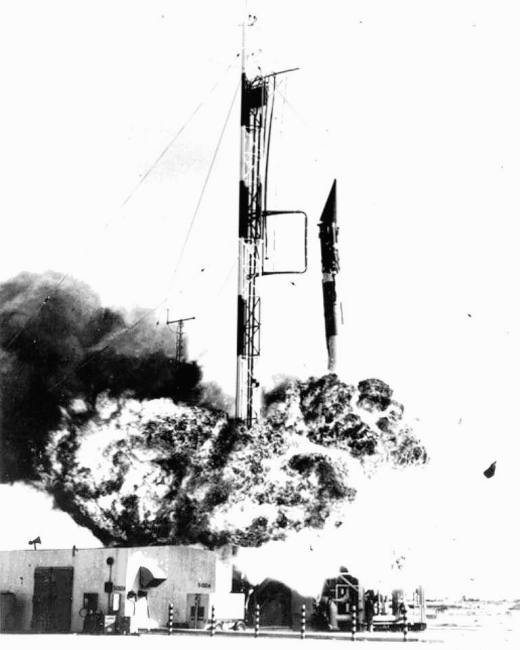.

WSPG/Navy The first Vanguard fails during the December 1957 launch
.
As the U.S. Navy struggled to build and launch what they hoped would be Earth's first artificial satellite, White Sands Proving Ground was testing the instruments the satellite would carry.
"A tiny needle in the sky with a thread 126 miles long today put man's first stitch in outer space," The Associated Press reported in 1957, in a story the Alamogordo Daily News published on April 11. "An Aerobee-Hi rocket bearing the instruments such as will be used in the earth satellite soared far over the New Mexico desert probing the fringes of space to pave the way for Project Vanguard."
The package was an aluminum "container about the size of a gallon can" that carried instrumentation to return data, via a radio transmitter, on upper atmospheric temperature, pressure and cosmic rays.
Winds delayed the launch at WSPG for a week, but when finally aloft the instrument package worked well, a follow-up AP story, dated April 12, stated. The only negative seemed to be "some disappointment expressed that the Aerobee hadn't gone higher"; a 1956 launch "with a similar payload (had) reached 164 miles."
The Navy also announced they intended to launch an Aerobee, with similar instrumentation, on April 16, the AP reported.
The U.S. began developing Project Vanguard in 1955. Launch was planned for 1957, early in the International Geophysical Year. Success, however, was initially elusive, and the Soviet Union was soon besting the U.S. in the Cold War-era space race. The Soviets launched the first artificial satellite, Sputnik 1, in October 1957; Sputnik 2 went up in November, carrying a canine.
"Well, we lost that race," Astounding Science Fiction Editor John Campbell declared in a January 1958 editorial. "Russian technology achieved an important milestone in human history – one that the United States tried for, talked about a lot, and didn't make. Various commentators have tried to gloss over the facts, ranging from efforts to demean the high accomplishment that Russians achieved, to pooh-poohing the importance of getting there first."
The embarrassed Navy quickly "fast-tracked" Vanguard, the website jpl.nasa.gov stated. The first launch in December 1957 was a "fiery" failure and "severely shook the morale of the American public." The booster rose six inches and exploded. While the satellite was blown off a distance, it did continue transmitting its beeps, NASA said.
What "eased" Vanguard's "national embarrassment" was Explorer 1, stated "Rockets of the World: A Modeler's Guide" (Peter Alway, 1993). Launched Feb. 1, 1958, Explorer was the work of Dr. Wernher von Braun, who had developed the German V-2 weapon, and then immigrated to the U.S. after World War II; Dr. James van Allen, whose radiation detection experiments were conducted post World War II at WSPG; and Dr. William Pickering, who headed the Jet Propulsion Laboratory.
"This put von Braun in the race — not with the Russians — but with our second satellite team, the Vanguard group," Erik Bergaust documented in "Wernher Von Braun" (National Space Institute, 1976). "Competition raged" so fiercely between America's Army, Navy, and Air Force, that "comical subterfuge" sometimes resulted, according to "Space: The Next Twenty-Five Years" (John Wiley & Sons, 1987). There were rumors "scientists actually hid a satellite in a closet so that government inspectors wouldn't detect that they were doing unauthorized work that was supposed to be done by the Air Force."
Not long after, the Navy did successfully launch a Vanguard. Nevertheless, Soviet Premier Nikita Khrushchev continued to ridicule America by pointing out the first Sputnik was the size of a beach ball, and the first successful Vanguard was grapefruit-sized. However, while the Vanguard payload weighed only 3.25 pounds, one of its two tracking transmitters, which was solar powered, did continue to operate until May 1964.
The Soviets not only were conquering the U.S. politically and technologically, but educationally as well. In 1957, "the Russians had about 1,500,000 in all the various (scientific) disciplines," Bergaust said. "The comparable United States figure for mid-1957 was 1,300,000. The Russians were ahead in terms of total scientific and technical manpower."
What also "frightened" the U.S. was "the manifest rocket power displayed by the Soviet launchings," according to "On The Seas And In The Skies: A History of the U.S. Navy's Air Power" (Hawthorn Books, 1970). "Only a stupendous blast-off could have shot the Sputniks into outer space. Such a blast-off more than substantiated Soviet claims that Russia had developed an ICBM that could take the Atlantic in its stride and hit any continent anywhere, with an atomic warhead."
While there were more Vanguard failures than successes, before the program ended in 1959 the successes returned data on Earth-reflected sunlight and magnetic fields; took solar X-rays; and recorded the effects of micrometeoroids.
The argument could be made that the U.S. actually launched satellites a dozen days after Sputnik I when, on Oct. 16, 1957, "artificial meteors" were part of an Aerobee payload, Wayne Mattson and Martyn Tagg wrote in "We Develop Missiles, Not Air!" (ACC/USAF Cultural Resources Publication No. 2, June 1955). The "meteors were released by a special explosive charge at an altitude of 48 miles." Some of them actually orbited "the sun and eventually burned up when they got closer to the sun."
Those "meteors" were ball bearings.
.
Quelle:Alamogordo News
